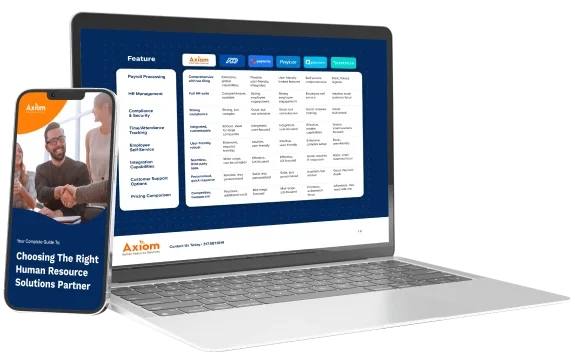Late Wednesday evening, President Trump signed the Families First CoronavirusResponse Act which, among other things addresses Emergency Family and Medical Leave and Paid Sick Leave requirements.
As we move forward, federal regulatory agencies, including the Department of Labor (DOL) and Health and Human Services (HHS), will provide employers guidance on how to execute or implement the new requirements. Axiom is providing a summary of the details below and will likely not be able to answer specific questions until additional agency guidelines are released which may take some time. We will update you as we receive more information.
Details
For certain circumstances related to COVID-19, employees will be eligible for:
- Up to two weeks of sick leave (full pay for self, 2/3 pay for family care) for illness, quarantine, or school closures
- Up to 12 weeks of Family and Medical Leave Act (FMLA) leave for school closures (10 days unpaid and then up to 10 weeks at 2/3 pay)
Effective Date
- April 2, 2020 until December 31, 2020
- There is no retroactive application.
Key Elements for Employers
- FMLA expansion
- Paid sick leave
- Payroll tax credit
- Group health plan benefit mandate
Emergency FMLA Expansion
- Covered Employers: Employers with fewer than 500 employees are covered.
- Covered Employees: Any employee who has been employed for at least 30 calendar days. (Employers may be able to exclude employees who are health care providers or emergency responders)
- Covered Leave Purpose: To care for a child under 18 of an employee if the child’s school or place of care has been closed, or the childcare provider is unavailable, due to a public health emergency, defined as an emergency with respect to the coronavirus declared by a federal, state, or local authority.
Duration
- Up to 12 weeks of job-protected leave
Compensation
- No pay for first 10 days of leave (other paid time off, and emergency sick leave under the FFCRA, may be applied)
- After 10 days, employers must pay two thirds of the employee’s regular rate of pay for the number of hours they would normally be scheduled to work, capped at $200/day and $10,000 total.
Reinstatement to Position After Leave
The same reinstatement provisions apply as under traditional FMLA. However, restoration to position does not apply to employers with fewer than 25 employees if certain conditions are met:
- The job no longer exists because of changes affecting employment caused by an economic downturn or other operating conditions that affect employment caused by a public health emergency;
- The employer makes reasonable efforts to return the employee to an equivalent position; and
- The employer makes efforts to contact a displaced employee if anything comes up within a year of when they would have returned to work.
The act reserves the right for the Secretary to exclude certain care providers and first responders from the list of eligible employees and to exempt small businesses with fewer than 50 employees if business viability is jeopardized.
Emergency Paid Sick Leave
- Covered Employees: All employees (no matter how long they have been employed), though employers may be able to exclude employees who are health care providers or emergency responders.
- Covered Employers: Employers with fewer than 500 employees.
- Covered Leave Purposes:
When quarantined or isolated subject to federal, state, or local quarantine/isolation order;
2. When advised by a health care provider to self-quarantine (due to concerns related to COVID-19);
3. When experiencing symptoms of COVID-19 and seeking a medical diagnosis;
4. When caring for an individual doing #1 or #2 (2/3 pay);
5. When caring for a child whose school or place of care is closed due to COVID-19 (2/3 pay); or
6. When the employee is experiencing any other substantially similar condition (2/3 pay).
Duration of Leave
- Full time employees are entitled to 80 hours of paid sick leave.
- Part time employees are entitled to sick leave equal to the number of hours worked on average over a typical two-week period.
Rate of Pay
- Sick leave must be paid at the employee’s regular rate of pay for leave used for the employee’s own illness, quarantine, or care.
- Sick leave must be paid at two-thirds of the employee’s regular rate if taken to care for a family member or to care for a child whose school has closed, or if the employee’s childcare provider is unavailable due to the coronavirus.
- Pay is capped at $511/day and $5,110 total for reasons 1, 2, and 3 described above.
- Pay is capped at $200/day and $2,000 total for reasons 4, 5, and 6 described above.
Interaction with Other Employer-Provided Paid Sick Leave and other Paid Leave
- This act does not preempt existing state and local paid sick leave requirements.
- Employers cannot require employees to use other leave first.
- Sick leave provided for under the act does not carry over from year to year, and the requirements expire December 31, 2020.
Notice Requirements
- Employers must post a model notice, which will be provided by the federal government.
Payroll Tax Credit
- Applies to both the emergency FMLA expansion and the emergency sick leave.
- Dollar for dollar credit for sick leave and paid FMLA wages against the employer portion of Social Security taxes.
- Refund is possible for amounts that exceed what is available as a credit.
- Limits on what can be claimed mirror the caps for what must be paid.
Health Plan Benefit Mandate - The act requires all insured and self-funded medical plans, including grandfathered plans, to cover diagnostic testing-related services for COVID-19 at 100 percent without any deductibles or co-pays.
- Examples include services provided by doctors, emergency rooms, and urgent care centers leading up to the decision that testing is needed, along with the actual lab-based testing.
- The mandate does not apply to treatment.

